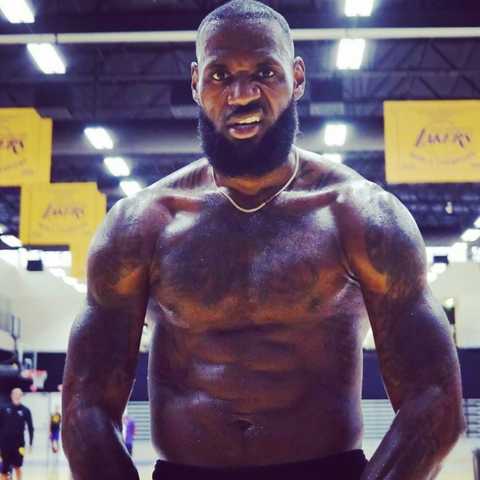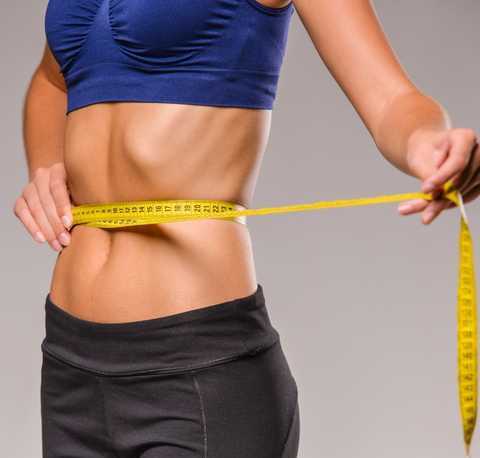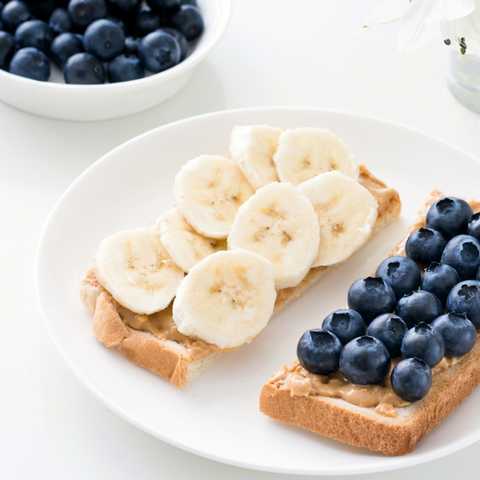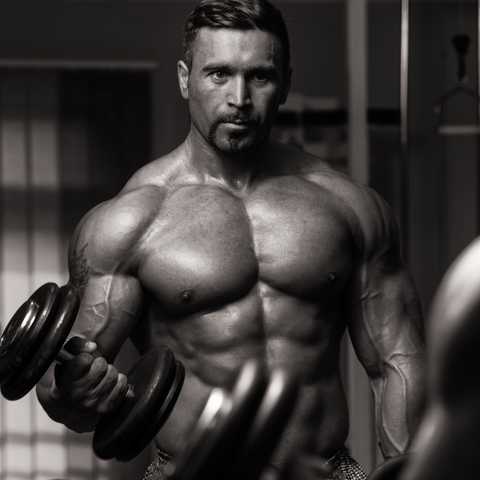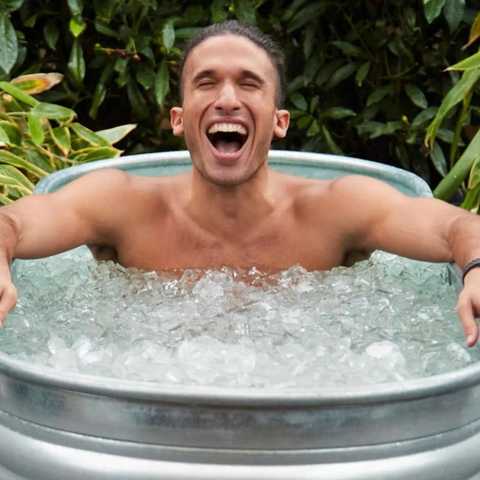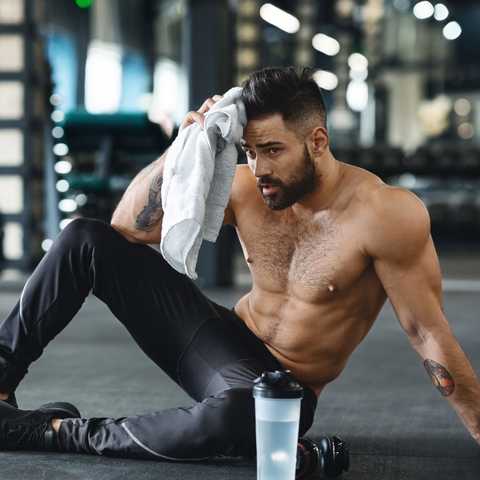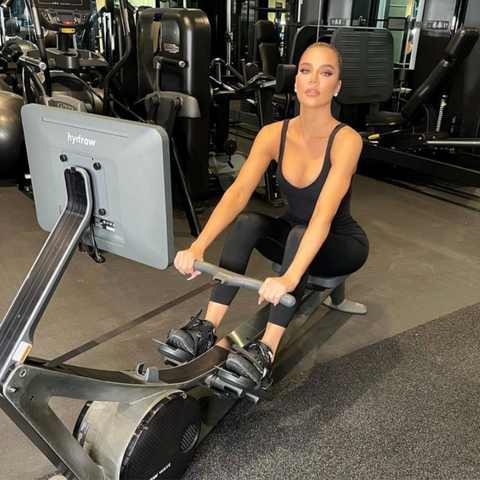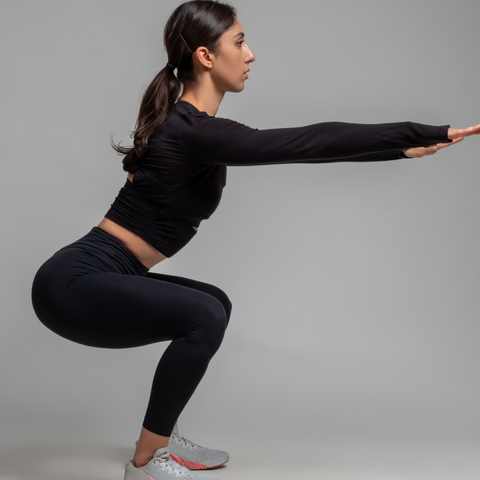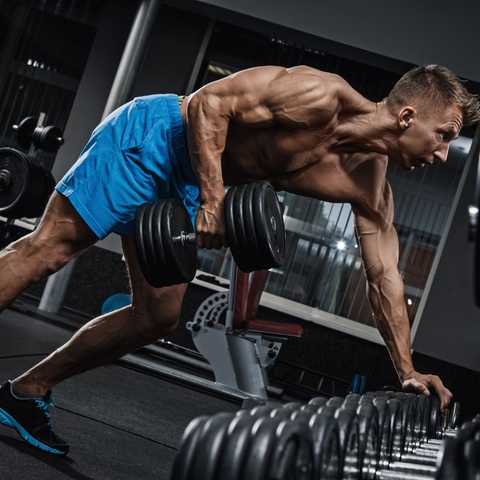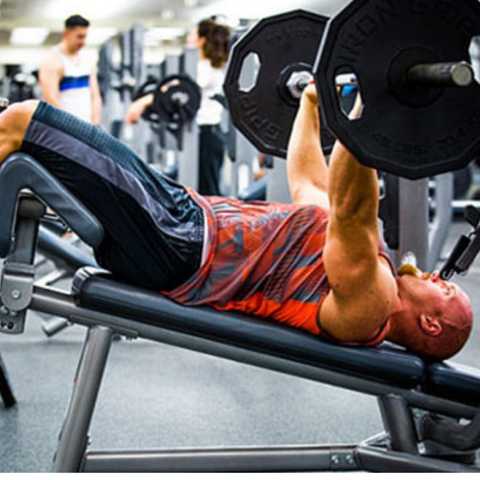We’re talking about the standing cable fly!
The cable fly separates itself from compound chest lifts due to its ability to load and isolate your pec muscles from multiple angles, making it an ultra-effective exercise.
And if you’ve never done the cable fly or are unfamiliar with cable machines, don’t let the piece of gym equipment intimidate you. It’s a very user-friendly piece of machinery that’s easy to adjust and manipulate.
We’ll discuss it all in detail in this article.
Table of Contents:
- What Is The Cable Fly?
- Muscles Used In The Standing Cable Fly
- How To Do Chest Cable Flys
- Common Mistakes to Avoid
- Cable Fly Form Tips
- Cable Fly Modifications
- Standing Cable Fly Variations
- Progressions of Cable Flys
- Programming Tips For the Cable Chest Fly Exercise
- Sample Chest Workout
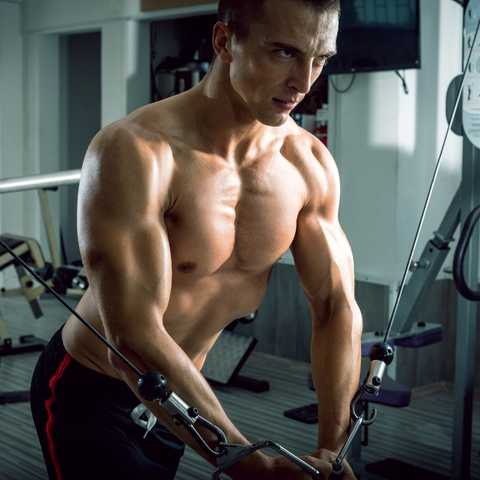
What is the Cable Chest Fly Exercise?
The cable fly is an isolation exercise targeting the pectoralis major and minor.
Whereas most chest exercises, like the chest press, are categorized as push movements in which the weight is pushed away from the chest, the cable fly exercise provides resistance concentrically and eccentrically, during the push phase and return phase of the movement.
This is one of the best exercises you can do to build your chest muscles as it provides a constant load on the chest throughout the entire range of motion of the fly. In addition, stepping further away from the machine or changing the angles of the pulleys adds an additional stretch to the chest muscles, which can contribute to greater chest development.
Isolating the chest with this exercise is an effective way to increase the muscular strength and growth of the chest muscles.
What Muscles Does the Standing cable fly work?
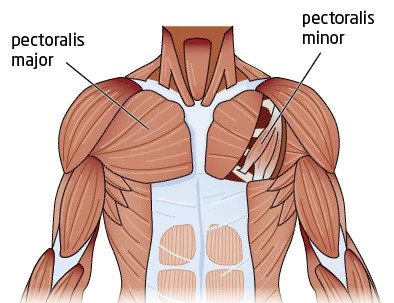
The muscles of the chest include the two pectoral muscles, pectoralis major and pectoralis minor, which are the main muscles targeted in the cable fly. The pectoralis major sits on top of the pectoralis minor and is visible to the eye. The pec major is in charge of adducting the arms, bringing them to the centerline of the body like hugging or clapping, in addition to flexion, inward rotation, and elevation.
Pec major has two heads and depending on the angle of activation in adduction, each muscle head can be worked differently. The upper head (clavicular head) is activated at an upward angle, and the lower head is activated at a downward angle.
Using low and high angles will target both pec major muscle heads. The pec minor, located deeper and under the pec major, contributes to the stabilization and moving of the shoulder blades in depression, protraction, and internal and downward rotation.
The pec minor works in synchronization with the pec major through cable flies.
How to Perform Standing Cable Chest Flys
These directions are for a standard cable chest fly where each pulley handle is adjusted to elbow height.
How to do Cable Flys:
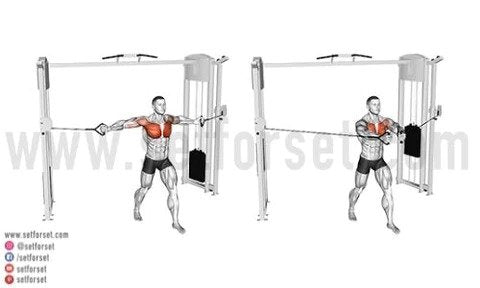
- Set each pulley on a dual-cable machine at elbow height. Stand in the center of the pulleys and grab each handle in one hand.
- Take 1-2 steps forward until you feel the cables slightly pulling you back. Keep your feet staggered with one foot forward and your body squared to the front.
- Press the pulleys out straight in front of your chest with your arms forward in a relatively straight line. Join your hands together and slightly bend through the elbows. This is your starting position.
- Extend your arms out horizontally to your sides until your upper arms are about 30 degrees away from your torso. Feel your chest muscles stretch. Make sure to maintain a slight elbow bend.
- Press against the pulley and bring the handles together. An option for additional activation is to cross one hand over the other.
- Pause at your start position to feel the activation of your chest then open up for your next repetition.
Common Mistakes to Avoid
To get the most out of your cable flys and ensure you’re building muscle in the chest, make sure to avoid these common mistakes.
1. Incorrect Body Position:
One of the main components of the chest fly is the deep stretch of the chest. In order to achieve this angle, the body’s position has to be at a proper angle.
Keep the shoulders down and back while emphasizing keeping the chest open, which allows the chest to create tension before the fly. Once the movement is in motion, the tension stays consistent.
Another key positional factor is keeping your feet staggered, pelvis slightly tucked under and core engaged throughout the movement. Focus on only driving movement from the upper body while keeping the rest of your body planted and resisting rotation.
2. Loading Heavy Weights:
Cables provide larger ranges of motion and have a wider degree of error since they are not fixed in one plane of motion (like stationary machines). When starting your sets off with too much weight, it is easy to lose control and fall out of form, causing the weights to pull you off center. If your weights are too heavy, you may start to roll shoulders forward, which places strain on your delts and take the work away from your pecs.
This can lead to potential injuries and unwanted stress within the joints. Lowering the weight allows you to gain control of the pulleys and access the rest of your body to stabilize your form and range of motion throughout the chest fly. If your body is not ready for an increase in weight, focus on factors like rep ranges and tempo.
Remember to prioritize your form and intensity of the exercise. Even with a “lighter” weight and focusing more on muscular endurance, you can still fatigue and challenge the muscles.
3. Driving Versus Bracing Through The Elbows:
When first moving through the cable fly, it can feel more natural to initiate the press by keeping your hands close and driving through the elbows, similar to the chest press. These two movements have a lot in common with their form and function.
But the cable fly is most effective when initiating a slight bend through the elbows and maintaining that bend throughout the entire motion. This directly isolates the chest, leaving the shoulders and triceps as stabilizers instead of primary movers, as seen in the bench press.
4. Hyperextending The Shoulder Joint:
This is yet another reason to start with lighter weights and slowly build up to heavier ones. Similar to dumbbell flys, the cables can pull you past a shoulder range of motion that you’re comfortable with. Really, the proper range to ensure proper shoulder blade stability is when your upper arms are 30 degrees away from your torso.
Surpassing this range can put unwanted stress and tension on the joint. To work your way up to this position, slow down as you start to reach your end range. Avoid allowing the weights to pull you into position, keep resisting with tension and control.
5. Limiting Forward Range of Motion:
Although this is more of a preference, adding a cable crossover at the forward range can increase stimulus in the chest. Extend your range by letting your hands meet together, then crossing one hand over another.
Make sure to alternate sides so that each hand is crossing over the other. Keep control in this range. Even if you do not prefer the crossover technique, make sure your hands come together as close as possible. Stopping too short can limit the full benefits of this exercise.
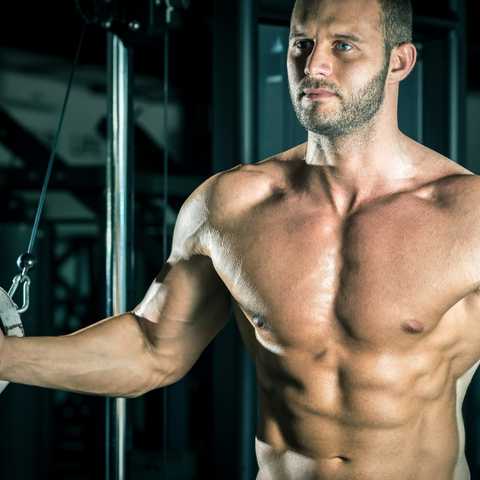
Cable Fly Form Tips
The main focus of this exercise is to maintain tension through your core, reducing compensation in your posture throughout the exercise. In addition, here are a few other tips to help you perfect your form:
- Mimic a hugging motion in front of you.
- Keep constant tension through your chest.
- Bend slightly through the elbows during the entire movement.
- Don’t allow the weight to pull you into a hyperextended shoulder joint position.
Benefits of Cable Flys
Building your chest muscles is reason enough to start doing this exercise! But, that’s not its only benefit. Here are seven more reasons why the cable fly is awesome.
- The exercise provides constant tension of the pec muscles through the entire range of motion (time under tension).
- There is less potential stress on the joints in comparison to dumbbell flys.
- The supported standing structure required for cable flies emphasizes control in the core and posture.
- It provides you with an opportunity to emphasize the eccentric lowering phase.
- The further away you are from the pulleys, the more stretch you’ll feel through the pecs.
- You have the ability to adjust the movement according to your current shoulder range of motion.
- You can target the upper, middle, and lower area of the chest, depending on the cable position.
3 Best Cable Fly Modifications
The cable fly is a single-joint exercise that maximizes tension within the pectoralis muscle group. You want to feel an intense stretch at the top movement with contractions at the end of the range. It is also dependent on how much or how little weight you load to feel these activations.
If you’re struggling to complete quality repetitions with both arms in the cable fly, there are several great variations to try. Here are 3 modifications to consider including in your routine.
1. Single Arm Cable Fly:
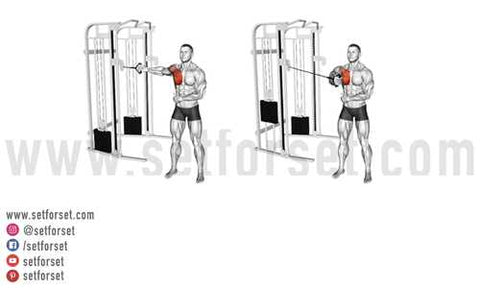
The easiest way to modify this exercise is by focusing on one arm at a time. This is also great for identifying any muscle imbalances. To set up for this exercise, position your body sideways to the front of the cable machine. The side of your body that’s working should be closest to the cable machine.
Keep your non-working hand on the chest muscles that are working.
Use your hand as external feedback to start connecting your chest muscles through the motion. When working with one arm at a time, ensure that the rest of your body stays grounded and resists rotation.
2. Banded Chest Fly:
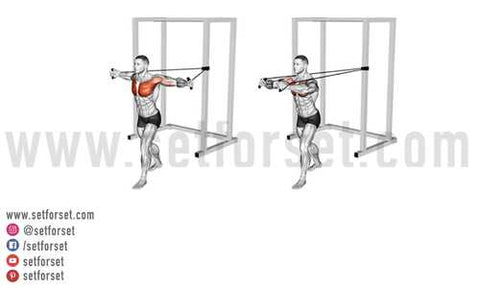
Another chest fly modification is a banded chest fly. You’ll need one looped band or a band with handles. Attach it to an anchor point and face away from the anchor point.
With the resistance of the band, you’ll feel enough tension through the chest while being able to focus on the form and activation of the chest muscles.
3. Seated Chest Fly Machine:

If you have a seated chest fly machine available to use, this is a great way to isolate the chest muscles without having to worry too much about the rest of your body’s position.
With stationary machines, your body is in a fixed position, allowing you to focus on your working muscles. Make the mind-muscle connection and slowly work your way up to more resistance.
4 Cable Fly Variations
Looking to spice up the standard cable fly? These four variations might just be the perfect addition to your workout split.
1. High Cable Fly:
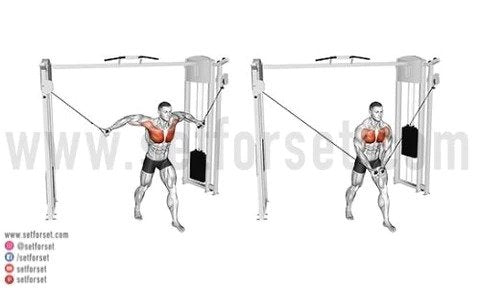
In addition to targeting the medial chest and lower chest, the angle of cable flys high to low activates the front deltoid and triceps.
The form does not change in comparison to your standard chest fly, although it may feel different as you’re activating more muscles from this angle.
How to do High To Low Cable Flys:
- Place each cable handle on the highest notch. Grab a handle in each hand and face away from the cable machine. Start with palms facing forward.
- Keep your arms close to your body and step forward until you feel the resistance of the pulleys.
- Stagger your feet and slightly hinge from your hips, sending your torso slightly forward while maintaining a squared stance toward the front.
- Press the pulleys forward so your hands meet and are slightly lower than chest height.
- Bend through your elbow and open out to the sides with control until you feel a deep stretch in your chest.
- Press the handles back to your start position with a big contraction from your chest. Reset for your next repetition.
2. Low Cable Flys:
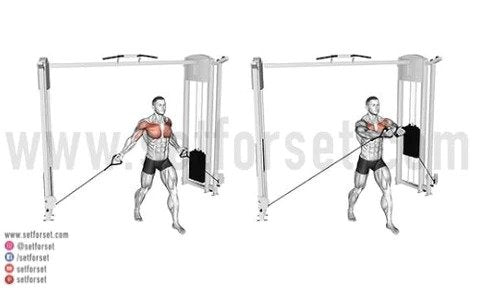
Low to high cable flys do a great job of targeting the upper chest muscles, an area that is the focal point of growth for those striving to improve the physique of the chest muscles.
With the low cable fly specifically, it is common to want to compensate with a lower back arch. Reset your form and posture if you start to feel this occur.
How to do Cable Flys Low To High:
- Adjust your cables to the lowest setting. Grab the handles and step forward in a staggered stance.
- Face your palms forwards and stay in a tall, proud posture.
- Keeping your elbows slightly bent and at your sides, exhale and pull the handles together until your elbows are aligned with your chest.
3. Dumbbell Flys:
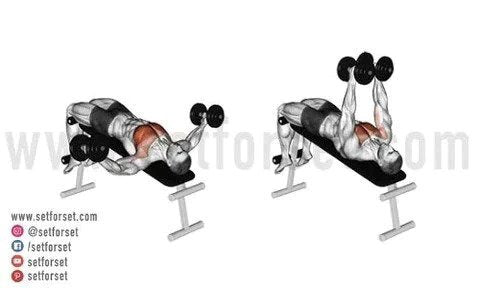
Dumbbell flys are one of our favorite dumbbell chest exercises. Using dumbbells instead of the cable machine is a great way to change the method of loading.
Gravity will be in play with the dumbbells and you may feel an additional challenge when lowering the dumbbells during the fly.
How to do the Dumbbell Fly:
- With a dumbbell in each hand, lie flat on a bench and keep your feet in contact with the floor.
- Press the dumbbells directly up and over your chest with your palms facing each other.
- Brace through your elbows and start to lower the dumbbells out to the sides as far as comfortable for your shoulders.
- Use your chest muscles to contract and pull the weights back over your chest.
4. Incline Dumbbell Fly:
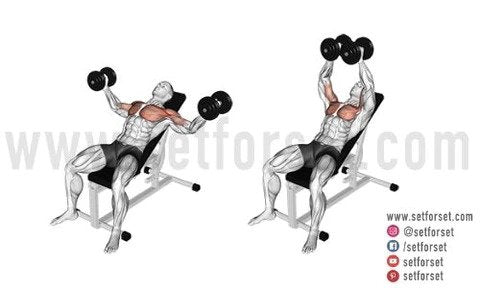
The incline of the bench changes the angle of the fly and targets more of the upper chest.
Pro Tip: Make sure to incorporate some chest stretches before and after your workouts!
How to the Incline Dumbbell Fly:
- Adjust your bench to a 30-degree incline.
- Lie back and perform your standard dumbbell chest fly, focusing on activating the upper chest muscles.
- Emphasize the stretch phase and make sure to avoid overstretching as you lower the dumbbells down.
2 Cable Fly Progressions
Ready to take your chest workout to the next level? Try one of these challenging cable fly progressions!
In addition to these progressions, another way to continue challenging yourself is to focus on time under tension by performing a 1.5 rep cable fly, a method that emphasizes the contraction of the chest and allows you to focus on the end range of the motion.
To do a 1.5 rep, squeeze your chest when your hands come together for the contraction of the fly, and then start to open outward to half of the range. Bring your hands together again and squeeze your chest. Return to start with a full repetition.
No matter where you’re at in your fitness journey, there’s always a way to make things harder!
1. Bench Cable Fly:
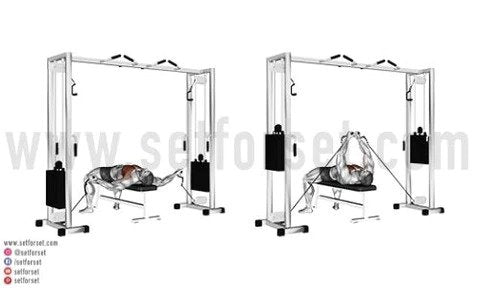
Adding a bench to the cable fly isolates the movement, serving as a way to change the position of your body, which makes it more challenging.
Since your body is lying down and stable on the bench, it’ll allow you to target the chest even more. For this progression, adjust a bench in the middle of the cable machine and position the cables at a low setting.
2. Eccentric Cable Fly:
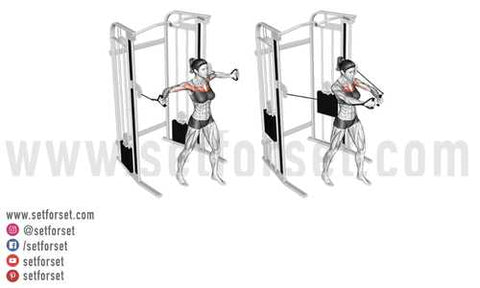
This progression eccentrically loads the chest muscles during the lowering phase of the movement (when the arms open for the fly). The form and overall movement stay the same. The only factor that changes is the tempo at which you’re pressing the weight.
Slow down the eccentric phase of the movement (opening the arms out) and hold the contraction (hands together or crossover position). This increases the time under tension of the muscles, which stimulates muscle activation and growth.
With eccentric loading, you’ll be challenged to control the weight as well as fight the tension through each count. Slowly lower the weights for anywhere from 3-10 counts (3 being standard and 10 being very challenging). Adding counts like this is another great progressive overload technique.
Cable Fly Programming
The cable fly is most effective when done after your compound lifts, as an accessory movement. It is a single-joint movement, meaning it recruits a smaller number of muscles in comparison to a multi-joint movement, like the barbell bench press, which uses multiple muscle groups at one time.
Since you are not lifting close to 1-rep max numbers with the cable fly, utilize this accessory exercise to hit moderate weights for 8-15 repetitions, focusing on muscle hypertrophy of the chest muscles. Week to week, try to increase the intensity of your cable fly in some way, whether that’s bumping up the weight, increasing repetitions, or adding time under tension.
Progressive overload is an important factor when it comes to improving your technique, strength, and muscle growth. Choose your program goal and starting point with the cable fly, then begin to load the intensity over time.
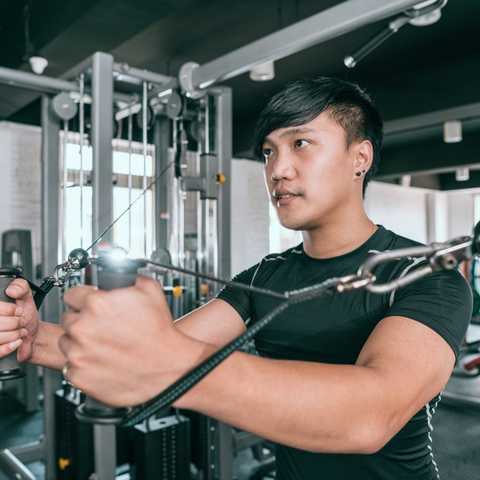
Sample Chest Workout
Looking for some chest fly workout inspiration? We’ve got a great routine for you!
- Neutral Grip Bench: 5×5
- Eccentric Incline DB Chest Press (3 Count Eccentric): 4×8
- Cable Chest Fly: 4×10
- Weighted Push Up: 3×12-15
Grow Your Chest With The Standing Cable Fly
Cable flys are a great accessory movement to add to your chest routine. The exercise can optimize muscle growth, while improving your pectoral muscles’ strength and helping you create a more defined and chiseled chest.
Regardless of where you are in your fitness journey, there is a modification, variation, or progression of the standing cable fly that is right for you. All that’s left to do is put in the work!
Looking for more great cable exercises to build your pecs? Check out our article on the 15 Best Cable Chest Exercises!

